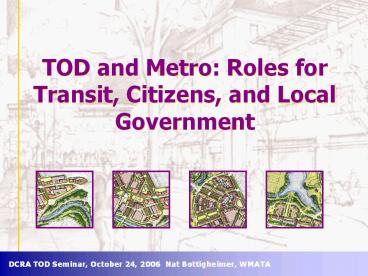DCRA TOD Seminar, October 24, 2006 Nat Bottigheimer, WMATA - PowerPoint PPT Presentation
Title:
DCRA TOD Seminar, October 24, 2006 Nat Bottigheimer, WMATA
Description:
DCRA TOD Seminar, October 24, 2006 Nat Bottigheimer, WMATA ... It is...the question that haunts smart growth and, if unanswered, threatens to ... – PowerPoint PPT presentation
Number of Views:53
Avg rating:3.0/5.0
Title: DCRA TOD Seminar, October 24, 2006 Nat Bottigheimer, WMATA
1
TOD and Metro Roles for Transit, Citizens, and
Local Government
- DCRA TOD Seminar, October 24, 2006 Nat
Bottigheimer, WMATA
2
Todays Talk
- Framing the challenge
- Metro and the region
- Affected communities
- Local government
- Addressing challenges
3
Benefits of Transit
- Rail removes 600,000 cars/day from our roads 75
million gallons of gas/year 10,000 tons of air
pollution - Eliminates the need for 1,400 highway lane miles
4
Characteristics of Transit-Oriented
Development
- Fairfax County Transit-Oriented
Development (TOD) Committee - Compact and walkable
- Not dominated by the car
- Safe attractive
- Complements surroundings
- Contains a mix of uses
- Its not any one single thing
5
Benefits of TOD
- Quality of Life
- Increased Mobility Choice
- Reduced Congestion
- Conservation of Land and Open Space
- Health Benefits
- Enhanced Sense of Community
- Economic Social Benefits
- Jobs-Housing Balance
- Redevelopment Opportunities
6
Framing the Challenge
- From last weeks Otis Whites Urban Notebook
- How does adding large numbers of people to a
neighborhood benefit those who are already there?
It isthe question that haunts smart growth and,
if unanswered, threatens to derail the entire
movement. - http//www.governing.com/notebook.htm
7
Why WMATA Interest?
- Generally, to increase ridership and revenue,
while - Minimizing stresses at peak
- Increasing off-peak travel
- Increasing contra flow travel
- Improving farebox recovery
- Increasing traveler choices
- Support infrastructure investment
8
WMATA Roles
- Station access plans
- Station area plans
- Joint development
- Participation in local and regional planning
processes - Testimony
- Information sharing (e.g., TPB, community
meetings)
9
How is TOD of Interest to Communities?
- Improved quality of lifeits not just about
transportation - Increased safety, certainty, independence,
options, and health for everyone - but seniors, kids, and disabled particularly
- Reduced traffic
- Increased values
10
What Community Issues Does TOD Raise?
- Competing views of community character
- Apprehension about TOD
- Imposition of outside vision
- Loss of control uncertainty
- Disruption
- Parking and traffic
11
Community Responses
- Community concerns are legitimate and paramount
- Burden of proof on change agents to assure
projects meet community needs - Openness to explore options that meet both public
and community need - Ability to articulate general conditions under
which projects can take place - Avoid starting conversations with specific
solutions - Just because an issue is first defined as a
transportation problem, doesnt mean a
transportation solution is neededexpand
conversations
12
Local Government and TOD
- Promotes revitalization
- Strengthens and diversifies tax base
- Reduces incremental traffic impacts of growth
- Can bring urban-style amenities and more
transportation choices to suburbs
13
Local Government Roles
- Planning, Zoning, Development Review
- Depending on jurisdiction streetscapes, transit,
signals, parks - Potential to identify issues that other public
agencies can address (e.g., State DOT, school
district, etc.)
14
Addressing Challenges
- Fairfax County TOD Committee
- Tysons Task Force
- Franconia-Springfield Station Area Planning
- Largo Town Center SAP
- TPBs Transportation Land Use Connection (TLC)
initiative for smart growth planning - Metros Joint Development Task Force
15
Partnership Approaches
- Broader scale visioning--not just transit land
- Agencies with policy interests take leadership
roles - All key stakeholders deeply involved in analysis
- Resources targeted to areas of greatest
uncertainty
16
Lessons Learned
- Yielding control yields results
- Accommodating multiple interests in a bound space
yields TOD outcomes - Bringing planning and implementation together is
critical to success - Planning means different things to different
people - Listen carefullyfor meaning and opportunities
17
Online Resources
- http//www.fairfaxcounty.gov/planning/tod.htm
- http//www.mncppc.org/cpd/PDFs/westhyattsvillefina
l.pdf - http//www.mncppc.org/cpd/PDFs/New_Carrollton_TOD_
Study.pdf - http//www.mncppc.org/cpd/central_avenue_ppt.htm
- http//www.wmata.com/bus2bus/jd/jointdev.cfm
- http//www4.trb.org/trb/crp.nsf/reference/boilerpl
ate/Attachments/file/25-25(20)_FR.pdf
18
TOD and Metro Roles for Transit, Citizens, and
Local Government
DCRA TOD Seminar, October 24, 2006 Nat
Bottigheimer, WMATA
19
Process-based TOD Checklist
- 360 degree stakeholder involvement?
- Have interests been clearly drawn out and
articulated in a problem-solving atmosphere? - Have trade-offs been explicitly addressed?
- Have planning and implementation tools been used
to resolve issues, as opposed to being ends in
themselves? - Has the area been viewed as a system?
- Have problems in one dimension been solved in
another dimension? - Land value flood plain pedestrian safety vs.
intersection throughput - Can all stakeholders see their contribution?
20
Checklist (more)
- Walk-arounds?
- What is the place telling you?
- Interactive visualization?
- Pedestrian and biking needs balanced with
vehicles? - Simultaneous vs. linear problem-solving?
- Economic analysis (market, finance)
- Green elements considered? LEED?
21
Challenges of Partnership
- Many cooks are needed, but whos the chef?
- Who has the lead and at what point?
- Lead agencies have to balance their goals,
values, perspectives, and tools with those of
others, and dedicate resources for all - Partners and stakeholders need to be given
meaningful role in project and problem
definition, and in project management - A big step into the void































